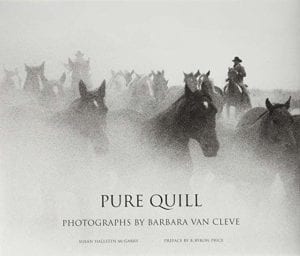
Winner of the 2017 IPPY Bronze Medal (Photography), the Best Photography Book from the Independent Press Awards, and the Western Heritage Award for Outstanding Photography Book at the National Cowboy & Western Heritage Museum, Pure Quill is a compelling view of the American West and its habitants as well as a closer look at photographer Van Cleve herself.
Fresco Books |frescobooks.com
Shelf Unbound: Tell us about the book’s title, Pure Quill.
Susan Hallsten McGarry: According to Barbara’s father, Spike Van Cleve, who authored two books of ranching short stories, the phrase pure quill means “authentic, real through and through.” As a Montana rancher and horsewoman, Barbara photographs the nitty-gritty of the world she knows. The phrase was also in sync with a book she wrote titled Hard Twist: Western Ranch Women (1995). The phrase hard twist refers to both a resilient rope as well as a small but strong person.
Shelf Unbound: As you mention in your prologue, you’ve followed Barbara Van Cleve’s work for decades. What do you find most intriguing about her photographs?
SHM: Unlike many contemporary western photographers, Barbara’s photos come from a lifelong working ranch perspective that includes being a rodeo rider in her younger years and an accomplished horsewoman to this day. Her photographs are documentary, and she’s chosen to make her statements in black-and-white. On average the photos are not posed. Rather, she watches or shadows her subjects engaged in daily activities and she’s often shooting on horseback. Her sophisticated eye for composition is a result of understanding what is happening (or about to happen) and then putting herself in place to capture it.
Shelf Unbound: You were the longtime editor in chief of Southwest Art magazine, writing primarily about paintings and sculpture. As a viewer, what do you experience from photographs that is different?
SHM: Considering today’s plethora of selfies and endless mundane moments forever frozen, I’ve had to question the value of photography. In fact, I imagine 100 years from now when people look back at the early 21st century and ask, What was their fixation on photographing what they ate for dinner? However, I’ve learned from Barbara that documentary photographs help keep traditions alive. Whether its clothing, family values, landscapes or animal husbandry, the history of a place or lifeway is perpetuated through images that seem even more “historical” when they are black-and-white. But Barbara is not a Luddite when it comes to technology. Throughout her seven-plus decades she has stepped up to the next best camera, and in 2004 she switched to high-tech digital cameras. Today, she also uses her smart-phone camera (with a DSLR-like manual control app) to document her world.
Shelf Unbound: Do you have a favorite photograph in the book?
SHM: I relate to many of them, but if actions speak louder than words, I’d have to say it is Big Corral: 70 Miles from Asphalt, Sandy Cook Rosenlund, which I placed upfront, across from the dedication. I love the zigzag composition of the shadows of the woman and open gate, as well as the tension created by dirt, tumbleweed, and fence rails crowding the margins of the image. It represents to me the reality of many working ranches that are in the middle of nowhere, forcing ranch women to survive on native intelligence. They don’t just call in a doctor or vet or “run over” to the grocery store. Challenges to body, mind, and spirit are dealt with through stamina and a belief in oneself—qualities that ring true for all of us, whatever the lifestyle.
Shelf Unbound: In interviewing Van Cleve for this book, what did you learn about her that you did not previously know that is particularly interesting to you?
SHM: Barbara has called herself a self-taught photographer. This is certainly true of her childhood when at age 11, she was given a Brownie box camera and then darkroom equipment that she taught herself to use. Later in life, she also devised unique methods for printing her heroic-scaled silver gelatin prints. What gets less coverage are her two decades as an academic and dean of women at colleges in Chicago. Although she spent summers in Montana, the rest of the year she was a professor of Victorian literature and photography, as well as founding a stock photography business. When at age 45 she decided to abandon academia and focus on fine-art photography, her acumen as both a photographer and business person allowed her to quickly position herself in the 1980s western art marketplace in Santa Fe, NM. I was also unfamiliar with several of her other series, including pure landscapes, nudes on horseback, and documentation of Baja, which was done over two decades of traveling the Spanish Mission Trail by mule. Although she is best known for ranching imagery, her photographic oeuvre and technical abilities are broad, including her most current series made using only the full moon as a light source.
